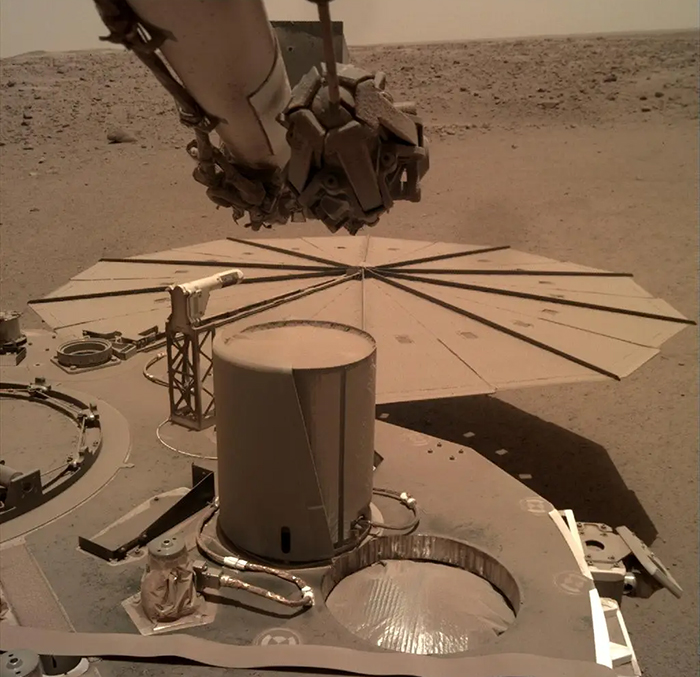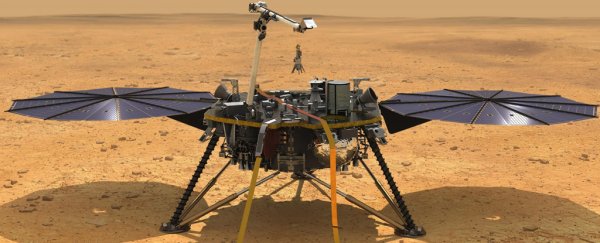NASA's $800 million Mars lander is in an energy crisis.
InSight, which landed in a Martian plain called Elysium Planitia in 2018, has detected more than 500 Mars quakes, felt more than 10,000 dust devils pass by, and started to measure the planet's core.
But over the past few months, InSight has been fighting for its life as the red planet's unpredictable weather threatens to snuff out the robot.
Unlike other sites where NASA has sent rovers and landers – including the landing spot of the new Perseverance rover and its Mars helicopter – powerful gusts of wind have not been sweeping Elysium Planitia.
These winds, called "cleaning events," are needed to blow the red Martian dust off the solar panels of NASA's robots. Without their help, a thick layer of dust has accumulated on InSight, and it's struggling to absorb sunlight.
 (NASA/JPL-Caltech)
(NASA/JPL-Caltech)
Above: The InSight lander's camera captured an image of one of its solar panels covered in dust on February 14.
InSight's solar panels were producing just 27 percent of their energy capacity in February, when winter was arriving in Elysium Planitia.
So NASA decided to put the lander in "hibernation mode," switching off different instruments each day. Soon the robot will shut down all functions that aren't necessary for its survival.
By pausing its scientific operations, the lander should be able to save enough power to keep its systems warm through the frigid Martian nights, when temperatures can drop to negative-130 degrees Fahrenheit.
"The amount of power available over the next few months will really be driven by the weather," Chuck Scott, InSight's project manager, said in a statement.
Now almost halfway through its expected hibernation period, InSight is still in good condition, but the risk of a potentially fatal power failure is ever-present. If the lander's batteries die, it might never recover.
"We would be hopeful that we'd be able to bring it back back to life, especially if it's not asleep or dead for a long period of time," Bruce Banerdt, InSight's principal investigator, told Insider. "But that would be a dicey situation."
The agency expects to restart InSight's full operations after Mars swings back toward the sun in July. If it can survive this Martian winter, the lander could keep listening for quakes and tracking weather into 2022.
InSight's power shortage contributed to NASA's decision to abandon the lander's "mole" in January. That burrowing probe was supposed to measure the temperature deep in the Martian crust – crucial data in the study of the planet's history and internal structure.
Now scientists are missing out on even more data as the lander shuts down its instruments. Its Mars weather measurements have become scarce, and in the next month or so, it will stop listening for quakes.
Banerdt said he fears the lander could miss some big quakes, but it's worth it to keep the robot alive. If InSight's batteries die, he added, "it's a good zombie spacecraft" – meaning it's programmed to recharge and start up again once the sun comes out.
"The problem with that scenario is that in the meantime, the spacecraft is very, very cold. And this is happening during the coldest part of the year for the spacecraft," Banerdt said. "A lot of the electronics is pretty delicate. And it's, unfortunately, pretty likely that something would be damaged by the cold."
Banerdt suspects that's what happened to the Spirit and Opportunity rovers. Both ran out of energy on the Martian surface and were unable to power up again. He's hopeful that InSight won't have to die, though.
"Right now, our predictions, our projections are that we should be able to make it through the lowest-power point and come out the other side," Banerdt said.
Still, an odd dust storm in the next four or five months could tip the scales by piling more dirt onto InSight's solar panels. That's what happened to Opportunity. But luckily, it's not dust-storm season.
"We think we're pretty well off, but Mars is unpredictable. We never know exactly what's going to happen," Banerdt said.
This article was originally published by Business Insider.
More from Business Insider:
